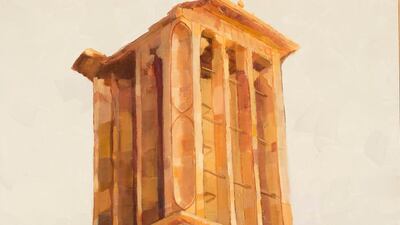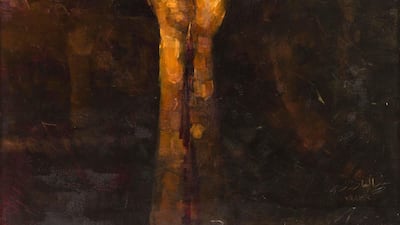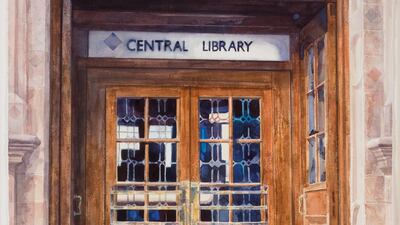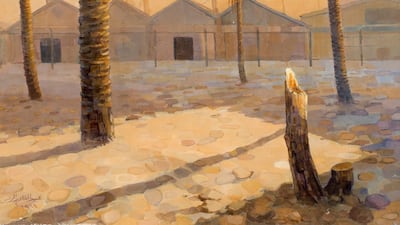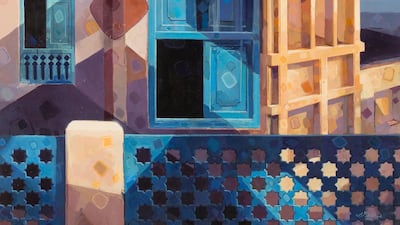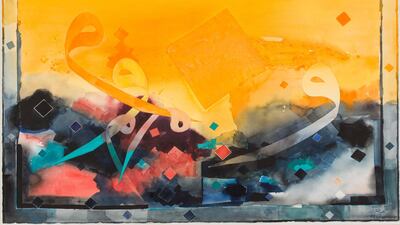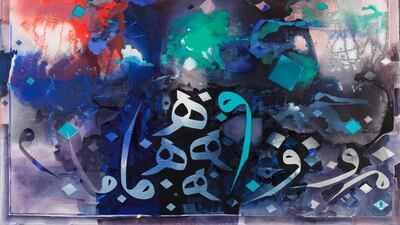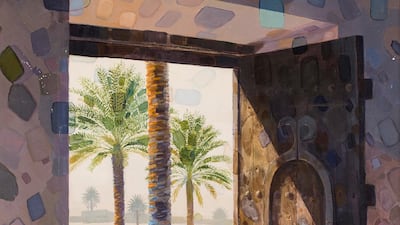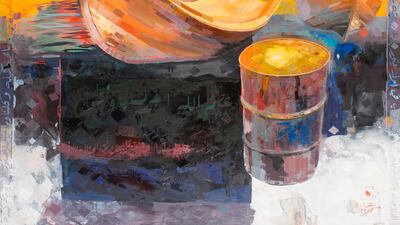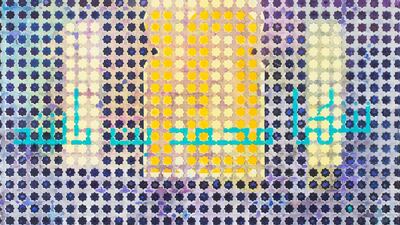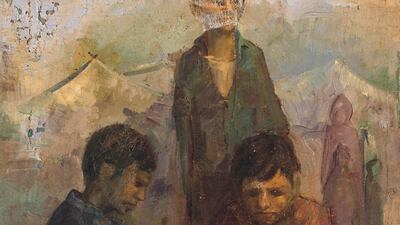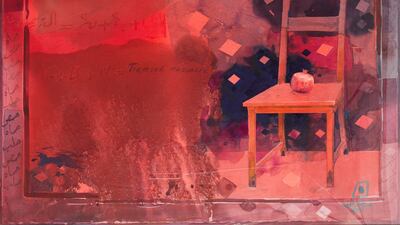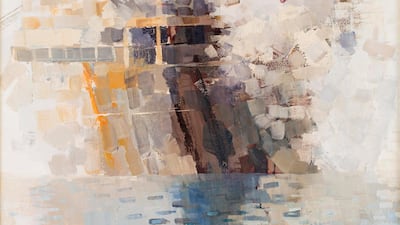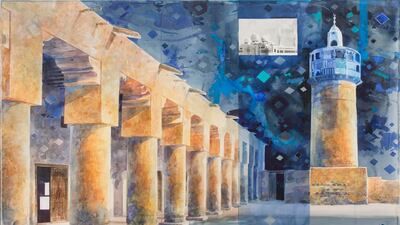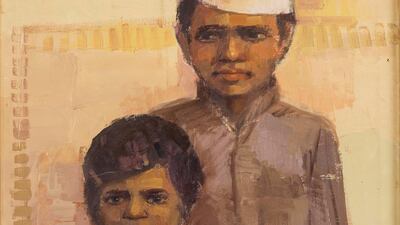One of the oldest paintings in Abdulqader Al Rais's retrospective exhibition, which opened in the Institut du Monde Arabe in Paris last week is called Al Intithar (The Wait). Painted in 1968, the oil-on-board work has not survived life in the desert climate well. There are clear signs of damage, including cracked and flaking paint and a large scratch partially concealing one of the faces of the three Palestinian boys who comprise the painting's subject matter. Nevertheless, the artwork exudes emotion. The boys are depicted with downcast eyes and slumped stances, and are rendered in muted colours. Tragically, the poignant title remains relevant even now, five decades later.
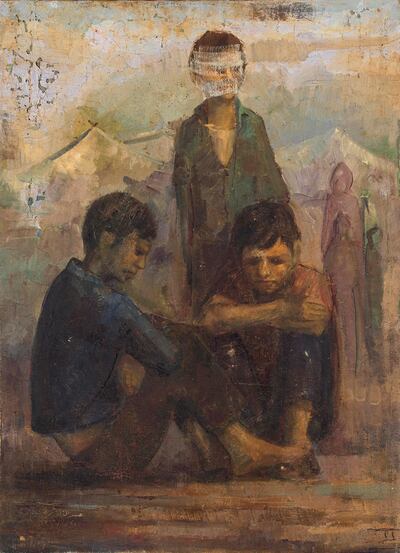
It is just one of the 50 paintings gathered for Al Rais’s first international retrospective organised by Dubai Arts and Culture Authority (Dubai Culture) and hosted in the French capital as part of the French-Emirati Cultural Dialogue programme for 2018. The work is important not only due to its age, but also because it is indicative of an under-documented strain of the artist’s practice and political protest.
Born in 1951, Abdul Qader Al Rais is widely credited as being the first Emirati to pursue art as a professional career. After his father died when he was nine years old, he was sent to live with his sister in Kuwait. At the beginning of the 1960s, Kuwait had gained its independence from Britain and was already a relatively prosperous state having discovered oil in commercial quantities in 1938. On the cultural front, it was also thriving. Al Rais benefited from this artistic and literary renaissance and visited Al Marsam Al Hurr (the "Free Studio") where he encountered key protagonists in the Gulf modern art movement including Sami Mohammed and the artist husband and wife team Khalifa and Lidia Qattan, who founded the artistic theory of circulism (an extension of cubism).
When he returned to the UAE after high school, Al Rais dedicated his professional life to his art, and won numerous national and regional prizes. He did, however, hit a creative block and took a 12-year career break between 1974 and 1986, during which time he got married, took a job at the Ministry of Labour and had seven children. His artistic style in the early days was inspired by the classical masters such as Rembrandt, Michelangelo and Raphael, which is shown in a fascination with light and shadow. Later, when he returned to the canvas in the 1980s, he had a new appreciation for colour and began to use brighter tones alongside architecture and landscapes. In the 1990s, the artist started leaning towards abstraction.
More recently, he has embraced that move and is now best-known for his abstract works that contain a plethora of primary colours and details of calligraphic letters and architectural features. His paintings are layered with geometric forms, usually squares and rectangles, which resemble brush strokes, but could also be seen as windows offering portholes for the eye to take a rest in the process of surveying the large-scale works.
However, what is rarely documented is that the subtle political activism seen in Al Intithar (The Wait) continued throughout his career. He painted it during his teenage years, spurred into action by the outbreak of the 1967 Arab-Israeli conflict. However, this was not just the fervour of rebellious youth. In 1987, he painted a particularly moving work, that he called Bourj el-Barajneh after the Palestinian refugee camp in Lebanon. It shows a single chained hand reaching up with an index finger as if struggling to escape the shadows and darkness.
In 2012, Al Rais painted a watercolour called The Chair, upon which a single pomegranate sits. Within the paint layers, the artist has written the names of destroyed Syrian cities and included mathematical equations into the blood-red and black tones. One of those equations questions the death toll of the Battle of Tremseh that took place in 2012 and where hundreds of Syrians were killed and placed inside a local mosque.
A quiet family man with a reserved character and a gentle spirit, Al Rais is humble about his talent and is not the kind of person to be openly vocal about his underlying messages of protest. Nonetheless, they are there, and they add an extra dimension to the long career of one of the UAE’s pioneering artists.
A visitor to the exhibition in Paris will see Al Rais's practice divided into three approximate periods: his early beginnings, the works after the career break and pieces made in the 20th century – presented in concentric layers. The outermost zone serves as an introduction to the artist Al Rais is today and features abstract works painted in vivid colours and hung on black walls. The most impressive of these are the large watercolours from the Waw and Serenity series. Using watercolour over a large scale is particularly difficult because of the speed with which it dries, and the artist is undoubtedly supremely talented in mastering this medium.
The second and central layer of the exhibition is painted with grey walls and represents the return to canvas after his break. Here, his exploration of varying thematics and forms of expression appear, and they also bear historical significance. A Sad Afternoon from 1989 exhibits a commentary upon the rapid urbanisation of the UAE. The severed trunks of palm trees populate the foreground, while cranes and oil rigs encroach on the scene from behind.
The inner section is a place for the earliest pieces in the exhibition. Bright white walls and smaller paintings offer a more intimate experience. This area could be seen as a metaphor for the innermost sanctuary of the artist’s mind. Many audiences in Europe may be experiencing his works for the first time, and as such, the exhibition serves as an introduction to the UAE’s history and culture as well as displaying the artist’s versatility. It also supports Dubai Culture’s overall aim to strengthen the UAE’s global reputation and so, simultaneously tells a deeply personal story as well as one of the nation as a whole.
Abdul Qader Al Rais’s retrospective is on show at the Institut du Monde Arabe in Paris until October 21
_______________________
Read more:
How Sheikha Hoor Al Qasimi brought new life to Sharjah's arts scene
In the Frame: What Camille Zakharia's latest work says about his experience with immigration
Kingdom of Khatt: Egypt’s love affair with calligraphy - in pictures
_______________________

